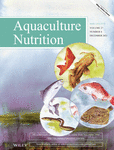Effects of feed supplemented with probiotics on the culture of sea cucumber Apostichopus japonicus
Abstract
In this study, mixed feed (MF), a mixture of probiotics and formulated feed, were fed to sea cucumbers Apostichopus japonicus. The specific growth rate (SGR) and weight gain (WG) of sea cucumbers, the crude protein content (CPC) and protease activity (PA) in different parts of their intestines, feed conversion ratio (FCR) and protein efficiency ratio (PER), as well as the water quality of the culture water, were determined and compared with that of the control (formulated feed, FF) diet. The results showed that WG and PER of sea cucumbers were significantly (p < .05) higher in MF groups compared with FF groups. The SGR and PA in the intestines of MF groups increased significantly (p < .01) compared with FF groups. The CPC in the intestines of MF individuals was far lower (p < .01) than FF ones. The FCR was significantly (p < .05) lower in MF groups than the control groups. The culture water in MF groups showed lower (p < .05) levels of ammonia–nitrogen and nitrite–nitrogen than in the other groups. These results revealed that probiotics enhanced growth performance, PER and PA, and improved water quality in culture aquariums. The addition of probiotics to feed was beneficial for sea cucumbers and maybe good for other aquaculture animals.
1 INTRODUCTION
The sea cucumber Apostichopus japonicus is one of the most popular aquaculture products in China, Korea and Japan because of its high nutritional value (Bao et al., 2017). In recent years, to meet the market demand for sea cucumbers, farmers have begun to increase their stock of sea cucumbers (Han et al., 2016). As the number of cultured sea cucumbers increases, the choice of a suitable diet becomes increasingly important. The seaweed Sargassum thunbergii is regarded as a favourable diet for sea cucumber for a long period (Shi et al., 2013). However, its high price limits its large-scale use in the sea cucumber farming (Wu et al., 2015). Therefore, a new suitable diet is urgently needed. The commonly used formulated feed has a balanced nutrition and lower price, and it is therefore widely regarded as a suitable diet for sea cucumber culture (Liu et al., 2010).
Protein is a valuable source in aquaculture diets and can bring benefits to aquaculture species in terms of growth performance and animal health (Tibbetts et al., 2000). The protein content in formulated feed is an important factor affecting the growth of sea cucumbers (Xia et al., 2018). Many factors can negatively impact the protein content of feed, such as imbalanced amino acid profiles and antinutritional factors, which result in poor protein conversion efficiency in aquaculture species (Hassaan et al., 2020). Furthermore, excessive amounts of unconsumed protein in marine organism excrement can cause low oxygen content, high phosphorus–nitrogen and ammonia–nitrogen in aquaculture ponds, thereby leading to eutrophication and red tide, and ultimately influencing the health of marine organisms (Qiao et al., 2020; Tada et al., 2001). Enzyme activities in the intestinal tract can potentially affect feed conversion efficiency and growth performance (Li et al., 2017). The activity of protease, an indispensable enzyme in fish intestines, has been confirmed to improve food utilization (Liu et al., 2018). On the culture of Oreochromis mossambicus, multi-enzymes present in diets could enhance protein utilization (Hlophe-Ginindza et al., 2016).
Probiotics are live microorganisms that are distributed in animal intestines and can bring many benefits to the host (Irianto & Austin, 2002; Sánchez et al., 2017). Probiotics may have a beneficial effect on the intestinal microbial population, enhancing enzyme activity, feed efficiency and improving the growth of some aquaculture species, such as fish and shrimp (Nimrat et al., 2013; Wu et al., 2012). Probiotics could protect aquatic animals from pathogenic infection and enhance the animals’ health status (Feng et al., 2020). Yeast supplement may improve the growth, feed utilization and disease resistance of Mystus cavasius (Banu et al., 2020).
This study was carried out to evaluate the effects of probiotics as feed additive on growth rate, crude protein conversion efficiency, protease activity of intestines and water quality of sea cucumber aquariums.
2 MATERIALS AND METHODS
2.1 Experiment animals
Sea cucumbers (Apostichopus japonicus) were collected from a local farm in Weihai, Shandong Province, China. The body weight of each sea cucumber ranged from 40 to 45 g.
2.2 Experimental diets
Formulated feed and probiotics effective microorganisms (EM) were provided by Weihai Jinpai Biotechnology Co., Ltd. The formulated feed contained 1.78 g kg-1 crude protein, 0.51 g kg-1 total carbohydrates and 0.09 g kg-1 free amino acids. EM is composed of both bacteria (1 × 109 cfu mL) and yeast (2 × 107 cfu/ml). Mixed feed was a mixture of formulated feed and EM in a ratio of 1:2 (W/V), followed by incubation at 30 ± 2°C for 8 h. Mixed feed contained 1.99 g kg-1 crude protein, 0.66 g kg-1 total carbohydrates and 0.10 g kg-1 free amino acids.
2.3 Feeding trail
The sea cucumbers were acclimated for 2 weeks in the laboratory, during which they were fed formulated feed at 2% of their body weight once a day. The sea cucumbers were then starved for 1 day, and all individuals with initial body weights of 40–45 g (randomly selected) were placed into six 500 L glass aquariums containing 200 L seawater, with continuous aeration. The total weight of sea cucumbers per aquarium was approximately 3.3 kg m-3 , and one aquarium contains about 15 individuals. The six glass aquariums were further divided into two groups, and each group was treated in triplicate. One group was fed formulated feed, whereas the other group was fed mixed feed. All diets were mixed with sea mud at a weight ratio of 1:2 before feeding (Xie et al., 2016). The remaining uneaten feed and faeces were syphoned before changing the water, one-third of water was exchanged with sand-filtered seawater in the afternoon every day, and seawater was exchanged fully every 7 days (Wang et al., 2020). During the experiment, the levels of dissolved oxygen in water were maintained above 5.0 mg L−1, the temperature of culture was maintained at 20 ± 2°C, pH was maintained at 7.5–8.0, and water salinity was maintained at 25–30‰.
2.4 Growth trial




2.5 Crude protein content

2.6 Protease activity
The contents of the fore, mid and hind intestine and the corresponding intestinal wall were put into 10 times volumes of phosphate buffer (pH7.0), homogenized and incubated in crushed ice for 10–15 min. The resulting homogenate samples were stored at 4°C for 12 h until the digestive enzymes were completely dissolved, and then centrifuged at 4,000 × g at 4°C for 20 min. The supernatant solution was collected and subsequently analysed within 24 h. The Folin's–phenol reagent method was used to measure protease activity (PA) (Lowry et al., 1951). The assay kit was developed by Jiancheng Bioengineering Institute (Nanjing, China). The experimental process was as follows: 800 mL of 50 mmol phosphate buffer (pH 7.0) containing 0.05 g kg-1 casein and 200 μL of crude enzyme preparation were mixed fully and incubated for 30 min at 37°C. The reaction was stopped by adding 270 μL of 1 mol L−1 acetic acid and 0.67 mol L−1 sodium acetate solution containing 0.54 g kg-1 trichloroacetic acid. After a further 30 min, the mixture was centrifuged and the liberated proteolytic peptides were estimated by the method of Lowry. One unit of protease was defined as production of 1 μg tyrosine that hydroxylation of casein at 37°C per minute. The mixtures were mixed fully, and the optical density of the mixtures was measured at 680 nm with a 721 spectrophotometer (Shanghai Jinghua Technology Instrument Co., Ltd.).
2.7 Water quality
During the trial period, the concentration of ammonia–nitrogen and nitrite in the culturing water of sea cucumbers was determined following the standard analysis every day (Grasshoff et al., 1999).
2.8 Statistical analysis
Data analyses were performed using the one-way ANOVA test, combined with Tukey multiple range tests using SPSS, version19. Statistical differences were expressed at the level of p < .05. Values are expressed as mean ± SD (n = 3).
2.9 Ethics statement
Apostichopus japonicus is a species for aquaculture. All experiments in this study were approved by the animal care and use guideline of the Institute of Applied Marine Microbiology, Harbin Institute of Technology.
3 RESULTS
3.1 Growth performance
The specific growth rate (SGR) and weight gain (WG) of the two groups of sea cucumbers after 49 days of feeding are shown in Figures 1 and 2. The sea cucumbers fed with mixed feed showed better growth performance, and their SGR increased from 0.93%/d to 1.31%/d (p < .05), and their WG increased from 6.73% to 9.23% (p < .05). In contrast, the SGR of sea cucumbers fed formulated feed increased from 0.78%/d to 0.92%/d (p > .05), and their WG increased from 5.63% to 6.66% (p > .05).
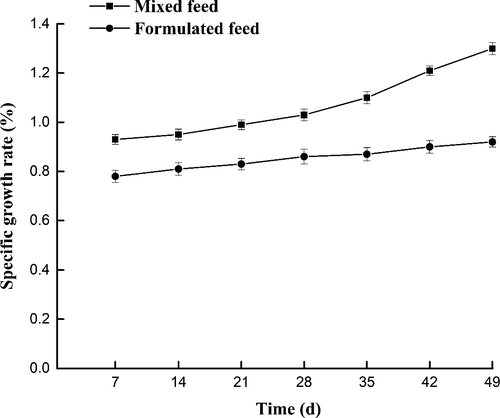

3.2 Crude protein content in sea cucumber intestines
The CPC in the sea cucumber intestinal tract is shown in Figures 3a, b. The initial CPC in groups fed the formulated feed and mixed feed were 17.84% and 19.89%, respectively. After 28 days, the CPC in the intestine decreased significantly in sea cucumbers fed the mixed feed (p < .05), which was lower than that in those fed the formulated feed. After 49 days, the CPC in the fore, mid and hind intestine of sea cucumbers fed the mixed feed were 5.04%, 4.902% and 4.11%, and 6.24%, 6.01% and 5.67%, respectively, in sea cucumbers fed formulated feed. The CPC was the highest in the fore intestine and the lowest in the hind intestine of both groups.
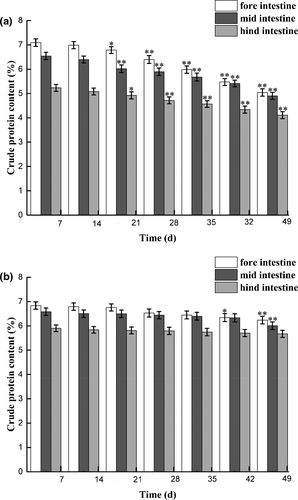
3.3 Protease activity
Protease activity (PA) in the fore intestine and fore intestinal wall of sea cucumbers is shown in Figure 4a. Protease content in the fore-intestine content was higher than that in the intestinal wall (p < .05). For sea cucumbers fed the mixed feed, PA increased from 116.757 U g−1 to 162.136 U g−1 in the fore intestine and from 35.971 U g−1 to 50.712 U g−1 in the fore intestinal wall. For sea cucumbers fed the formulated feed, the PA increased from 112.422 U g−1 to 140.824 U g−1 in the fore intestine and from 33.370 U g−1 to 42.908 U g−1 in the fore intestinal wall.
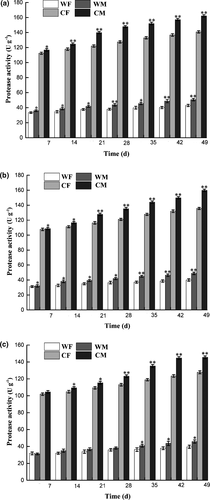
The PA in the mid intestine and mid intestinal wall of sea cucumbers is shown in Figure 4b. Protease content in the mid intestine was higher than that in the intestinal wall (p < .05). For groups fed mixed feed, PA increased from 108.664 U g−1 to 159.824 U g−1 in the mid intestinal content and increased from 32.069 U g−1 to 48.833 U g−1 in the mid intestinal wall. For groups fed formulated feed, the PA was increased from 107.653 U g−1 to 135.633 U g−1 in the mid intestinal content and increased from 31.202 U g−1 to 40.017 U g−1 mid intestinal wall.
The PA in the hind intestine and hind intestinal wall of sea cucumbers is shown in Figure 4c. The protease content in the hind intestine was higher than that in the hind intestinal wall (p < .05). For sea cucumbers fed mixed feed, the PA increased from 104.473 U g−1 to 145.517 U g−1 in the hind intestinal content and from 31.202 U g−1 to 45.798 U g−1 in the hind intestinal wall. For sea cucumbers fed with formulated feed, PA increased from 101.872 U g−1 to 127.748 U g−1 in the hind intestine and from 31.780 U g−1 to 39.584 U g−1 in the hind intestinal wall.
At the same time, PA in the fore intestine was higher than that in the mid and hind intestine. PA in the intestine was more than three times that in the intestinal walls in both groups.
3.4 Feed conversion ratio and protein efficiency ratio
The FCR of the two groups of sea cucumbers after 49 days of feeding is shown in Figure 5. The sea cucumbers fed with formulated feed showed higher FCR than other groups, and their FCR between 2.24 and 2.63 (p < .05). The FCR of sea cucumbers fed mixed feed between 1.66 and 2.22.
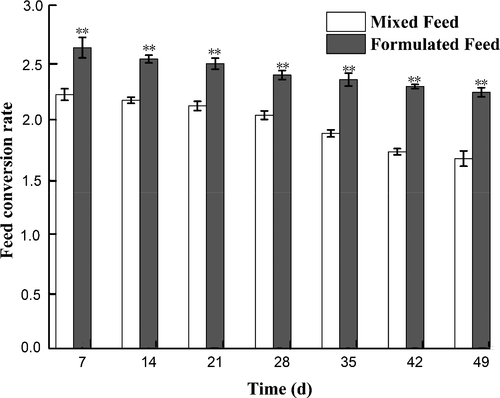
The PER of the two groups of sea cucumbers after 49 days of feeding is shown in Figure 6. The sea cucumbers fed with mixed feed showed better PER than other groups, and their PER between 2.26 and 3.03 (p < .05). The PER of sea cucumbers fed formulated feed between 2.13 and 2.51.
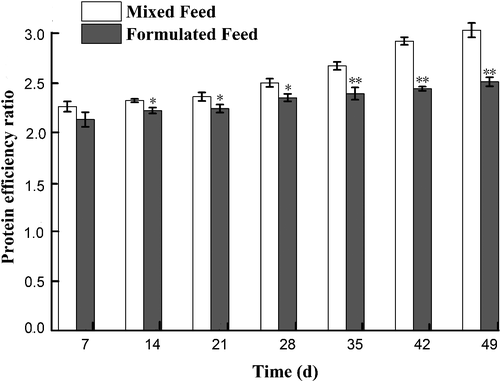
3.5 Water quality
The ammonia–nitrogen and nitrite–nitrogen levels were different between the two groups (Figure 7). The ammonia–nitrogen levels were maintained at 0.021 mg L−1 to 0.052 mg L−1 in the mixed feed groups and were raised from 0.020 mg L−1 to 0.306 mg L−1 in the formulated feed groups. The nitrite–nitrogen levels were maintained at 0.004 mg L−1 to 0.033 mg L−1 in the mixed feed groups and were raised from 0.005 mg L−1 to 0.127 mg L−1 in formulated feed groups. The ammonia–nitrogen and nitrite–nitrogen levels in the mixed feed groups were below the safe concentration (0.5 mg L−1 and 0.1 mg L−1, respectively), according to the Marine Water Quality Standard (GB 3097–1997).
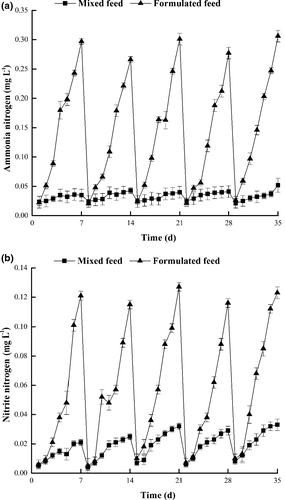
4 DISCUSSION
In our study, sea cucumbers fed mixed feed showed better specific growth rate and weight gain than those fed formulated feed. This excellent growth rate may be attributed to the activity of the probiotics in diets.
Many factors can influence the growth of sea cucumbers, and one of the most important of these is protein utilization (Shahabuddin et al., 2017; Wen et al., 2016). Protein is a necessary component in diets that can effectively improve the growth of aquaculture animals (Catacutan et al., 2001). Some aquaculture species, such as fishes, shrimps and sea cucumbers, have poor protein conversion efficiency, which can lead to lower food utilization (Hernández et al., 2008). Therefore, it is important to improve the protein conversion efficiency of aquaculture animals to reduce the waste of protein sources in diets. In the culture of rainbow trout and Pacific white shrimp, probiotics had the potential to increase the utilization of plant protein in diets (Amoah et al., 2019; Sahandi et al., 2019). In rohu and shrimp ponds, gastrointestinal bacteria are an ideal probiotic supplement in diets, improving the diversity of microbes and enhancing the digestion of nutrients (Ganguly & Prasad, 2012; Luis-Villaseñor et al., 2013). The protein efficiency ratio of Labeorohita increased after being fed probiotic-supplemented feed, which resulted in better growth performance and physical conditions (Mohapatra et al., 2012). Furthermore, some probiotic bacteria, such as Bacillus subtilis, have the potential to increase protein conversion efficiency and carbohydrate utilization in fish ponds (Kuebutornye et al., 2019). In our study, protein efficiency ratio in mixed feed groups was significantly higher than that in formulated feed groups, and sea cucumber fed with mixed feed showed lower crude protein content in the intestine, especially in the hind intestine, than those fed with formulated diet. Protein content was obviously reduced in the fore intestine and mid intestine after seven days. These results suggest that probiotics enhance the protein absorption ability of the sea cucumber intestinal tract.
In fact, protein conversion efficiency depends on protease activity. The improved protein utilization observed in this study may be related to the secondary metabolites produced by probiotics (Ninawe & Selvin, 2009). Probiotics increase the content of protease, resulting in higher nutrient conservation efficiency in the sea cucumber intestines (Yang et al., 2016). Proteases are beneficial for increasing protein utilization by breaking down proteins into free amino acids (Lei et al., 2013). Suitable diets supplemented with probiotics can increase the activity of proteases, amylase and lipases, thus improving food intake and growth rate (Adel et al., 2017). In Penaeus vannamei culture, probiotics can effectively enrich food to alter protease activity (Wang, 2007). Common carp fed with probiotic-supplemented feed showed higher growth rates and protease conversation efficiencies than carp fed basal feed, which effectively reduced the cost of common carp culture (Yanbo & Zirong, 2006). In shrimp intestines, the specific protease activity of shrimp fed diets supplemented with Bacillus bacteria was high, which is closely associated with a host of enzyme synthesis by Bacillus (Liu et al., 2009). Similar results were also found in other aquaculture species, including the tilapia and gibel carp (Yu et al., 2016). In our study, protease activities in the fore, mid and hind intestine were significantly increased after feeding with probiotic-supplemented feed, and protease activities in the fore intestine were the highest, which may because the fore intestine is the primary site of stored digestive enzymes in sea cucumbers. These results suggest that the addition of probiotics to diets could enhance sea cucumber growth rates and protein efficiency ratio by improving the protease activity in sea cucumber intestines.
In our study, probiotics are mixed with formulated feed and then incubated at 30°C for 8 h. The incubation process may increase the number of microorganisms in probiotics and stimulate the degradation of protein in formulated feed. Fermented feed could improve the growth performance of sea cucumber because the fermentation process could increase the content of small peptide and free amino acid in feed (Feng et al., 2020; Wang et al., 2017).
Water quality is a crucial factor in aquaculture systems, which strongly influences the health of animals (Parra et al., 2018). Poor water quality will also cause serious aquaculture animal diseases (Wang et al., 2015). Usually, the water quality is judged by the level of ammonia–nitrogen and nitrite–nitrogen in the water (Dai et al., 2020). Ammonia–nitrogen and nitrite–nitrogen are the main harmful substances for aquaculture species present in culture water because of the high levels of poisonous substances generated (Rodrigues et al., 2007). High levels of ammonia–nitrogen and nitrite–nitrogen can consume oxygen and damage culture animals (Harris et al., 1998). In aquaculture systems, ammonia–nitrogen and nitrite–nitrogen are mainly generated from unconsumed feed and animal excrement, and low protein utilization of aquaculture animals leads to higher concentrations of ammonia and nitrite in aquaculture water than that observed in flowing water (Hari et al., 2006). Probiotics are known to convert ammonia and nitrite into non-toxic nitrate to improve water quality (Padmavathi et al., 2012). The use of probiotics in aquaculture ponds can increase the removal rate of ammonia (Farzanfar, 2006). In our study, the levels of ammonia–nitrogen and nitrite–nitrogen in sea cucumber tanks supplemented with probiotics were far lower than in those without probiotics. This result suggests that probiotics result in better water quality by increasing protein efficiency ratio in the sea cucumber intestines and reducing ammonia toxicity in water. This may be one of the reasons why sea cucumbers fed with probiotic-supplemented diets showed a high growth rate.
In conclusion, this study indicated that the application of probiotics as an additive in feed could effectively enhance the growth rate of sea cucumbers and improve water quality by altering protease activity and protein utilization.
ACKNOWLEDGEMENTS
This work was supported by the Scientific and Technological Project of Weihai (No. IMJQ0110012). Discipline Construction Guide Foundation in Harbin Institute of Technology at Weihai (No. WH20150204 and No. WH20160205) and Research Innovation Foundation in Harbin Institute of Technology at Weihai (No. 2019KYCXJJYB15).
CONFLICT OF INTEREST
The authors declare that they have no conflicts of interest.
Open Research
DATA AVAILABILITY STATEMENT
The data used to support the findings of this study are included within the article.



